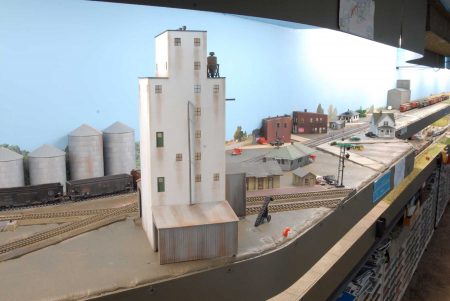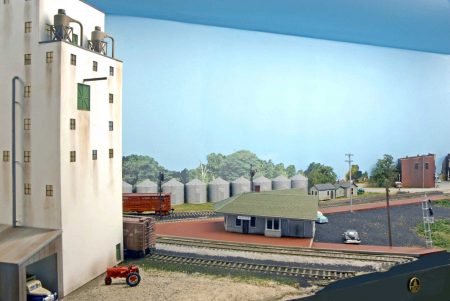
Tony Koester, editor of Kalmbach’s annual Model Railroad Planning and the Trains of Thought columnist and a contributing editor for Model Railroader, responded to an inquiry about his views of modeling a specific prototype vs. using one or more prototypes as the basis for a plausibly freelanced model railroad. Here’s Tony with more.
We keep trying to draw a line in the sand between prototype modeling and any form of freelancing. In my view, that’s both a waste of time and usually based upon faulty assumptions.
Let’s start with prototype modeling. As most of us who have done this to any extent have discovered, we are almost always faced with the choice of not getting much done, often owing to a lack of “complete” information, or the desire to make progress. “Analysis paralysis” is a very real aspect of prototype modeling. Many a grand plan has come to ruin on its shores.
For those who see realistic operation as a major or primary goal, that can buy the prototype modeler some time: Get the railroad running and don’t sweat the accuracy of things that can be added or upgraded later. In the latter category are locomotives and rolling stock as well as structures and even some scenery.

Indeed, a close look at my HO rendition of the Nickel Plate Road’s St. Louis Division as it appeared in 1954 will find all sorts of convenient shortcuts that make the railroad look more complete than it actually is. There are Bachmann Spectrum Consolidations that sort of resemble the prototypes for which they’re numbered. Several nicely painted and weathered Berkshires are of a later class of Lima graduates that never graced this division. A pair of kit-built or mocked-up depots stands in for the correct models. And some nicely weathered “blue box” freight cars, many of which saw service on Bill Darnaby’s Maumee Route before he was able to enforce his no-molded-on-grabs-or-ladders rule, fill out the roster.

My railroad gains realism points with each new addition, but I’ll wager that very, very few observers will note the upgrades. This is especially true of those who know the railroad best: my operating crew. They’re far more concerned that MB-98 and KC-44 are handled with alacrity, and that their fellow crew members are up to speed on how the railroad operated in a timetable and train-order environment. Two-person road crews help newcomers get up to speed.
One recent addition is a realistic-format waybill. Through the work of several modelers, notably Tony Thompson, Ted Pamperin, John King, Bill Neale, and me, we were able to scale down a prototype waybill to fit in “standard” Micro-Mark bill boxes, which are designed to hold the near-standard four-cycle waybills in car cards. They work just like four-cycle waybills except that there is no car card, only a clear plastic sleeve, and you shuffle the next bill from the bottom of a stack of two, four, or six bills to the top to “cycle” the car movement.
I also use actual Nickel Plate Road Form 19 and Clearance Form A manifold pads for our TT&TO environment. My supply of actual flimsies is getting low, however, and no printer we could locate wanted any part of printing on such paper and binding the sheets into trimmed pads. So I recently had reproductions printed on NCR paper.
With Steve King’s considerable help, I was able to create an Excel file for the schedule portion of the appropriate NKP employee timetable. The arrival/departure times at the anchor point, Frankfort (Ind.) Yard, are exactly the same as in the NKP timetable, but at all other points they are abridged to reflect the shorter runs between modeled towns.
We have thus followed Allen McClelland’s Good Enough principle in that my paperwork is as realistic as my rolling stock, scenery, and structures.
Only a few – but growing number of – modelers are this concerned about all aspects of the paperwork needed to move cars and trains. Yet many of them have railroads that otherwise surpass my own in overall realism. Interestingly, many of those are freelanced railroads, albeit closely based on prototypical operating principles.
So who is the “more faithful” prototype modeler? I am accurately modeling an actual railroad at a narrowly defined time and place. They are not, but the overall quality of their modeling and operating systems and their knowledge of prototype railroading surpass my own. Are they automatically disqualified from any discussion of prototype modeling because their locomotives, cabooses, and passenger cars bear a mythical road name?
I am building a one-town, sectional, portable layout in O scale for a series of articles for Model Railroader. The same layout can be constructed in O three-rail, O gauge (5 feet between the rails), or O fine scale, also called Proto:48. I chose the latter out of sheer curiosity, but it won’t be more than a short sidebar in the series.
Now, then, are those who model in “Ow5” – standard O gauge – automatically escorted out of the prototype-modeling arena because of the tiny gauge error? Conversely, does modeling to the correct gauge automatically confer points toward being a prototype modeler? Moreover, do I have to build everything to strict prototype dimensions and practices – grab irons, underbody detail, manual couplers, “working” air hoses, rail braces on turnouts, etc. – to qualify as not only a prototype modeler as well as a fine-scale modeler? Can’t I be content with simply correcting the gauge error, doing a decent job on everything else, and plant the flag of victory or the banner of the fine state of Good Enough?
We do indeed live in interesting times. This is about as good a time to be a scale model railroader as the hobby has even witnessed. Quality and variety are beyond our wildest expectations of a decade or two ago. We should rejoice in what we have or can acquire and not let petty concerns best labeled as rivet counting interfere with our enjoyment of what is truly the world’s greatest hobby. – Tony Koester
Special thanks to Tony Koester for sharing his modeling thoughts on the RCW blog. Our big picture hobby goals shouldn’t restrict our progress but offer inspiration to guide with the information, skills, and products currently at hand.
Questions and comments can be posted below. Please follow the instructions so your comment can be posted. All comments are reviewed and approved before they appear. To subscribe to this blog, enter your info for a comment and check the last box to notify of new posts by email. Share the blog link with other model railroaders.
Thank you Tony for reminding me of the trap of analysis paralysis. Too many project folders and not enough models done.
At the NEB&W, we take Allen McClelland’s concept one step further – “Good enough . . . for now.” There are lots of shortcuts we take with a whole progression of intermediate steps – cardboard mockup, closest kit, kitbashed kit, maybe finally a scratchbuilt version. It isn’t just to get things running but also as part of the planning process itself, which seems like it should never end. We’ve built some structures which looked great until they were placed in the context with other structures and sometimes that changes everything, for the worse.
Personally, I have worked on one area on our club layout not defined – it is a transition from one prototype to another within the overall scene – and I have spent SO much time trying to figure out what blends the two scenes. I have finished models only to find out that I am unhappy with the end result. So I try again, build some more models, try again. And again.
But absolutely the most important reason for us to follow something closely, as closely as possible, is that in a group setting, trying to ague what is reasonable or not often leads to hurt feelings, and members who leave. Settling on one prototype for each scene, even if jumping from prototype to prototype, minimizes the debates.
As one who learned Time Table and Train Order Operations on Paul Catapano’s Atlantic Inland Railroad before he had any scenery, I have to agree that Protolancing does not disqualify one’s layout from prototype modelling. Paul’s selection of car and locomotive types is plausible for 1953 Appalachian coal hauling, and it eliminates the but the Y-3s didn’t run on this branch issue. His back story of how the AIR came to be, where it ran, who it connected with, and what it hauled allowed him to maintain a wholly consistent chess board to re-create TT&TO operations as a 4 dimensional chess game (3D models and time). The attention to detail and accuracy in replicating the operation, be it TT&TO or Track Warrant Control as Jim Radkey implements on his fictional BNSF subdivision are Prototype Modeling.
I believe that Tony has stated it very well. Do the best you can to achieve realism but don’t sweat the detailed accuracy on everything or as he says, your layout will never be complete or useable. Some people achieve perfection on a few models or structures and feel they have done well for their layout. I think that no matter what approach you take, remember it must be fun for you and for whomever you choose to share with as friends. I have known some people that were so precise in model railroad operations that it was not fun to operate on their layout. I never went back to their layout. I am in this hobby for fun and enjoyment. Yes, I would like to be more precise in some areas but I choose to be more accurate in areas I am skilled at and just good enough where I am not so skilled. Guess what, I enjoy my layout and my friends that I invite enjoy it as well. We have fun, we don’t sweat the details to the point of not having fun. Enjoy the hobby to your satisfaction as you are really the one it matters.
Haven’t read the whole article but the thought that this whole Hobby is a reflection of our mind. I model the WM, Ma&Pa,N&W, RF&P and some B&O my layout is too small! 12 by 12 is about the largest I can get.the Ma &Pa would would be perfect but it can’t hold my interest
Free lance placement of features is important to me.